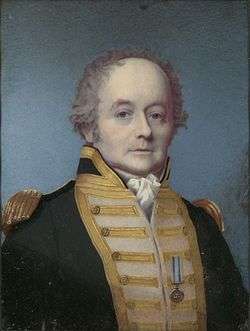HMS Bligh (K467)
HMS Bligh was a Captain-class frigate active during World War II. She was named after William Bligh, commander of HMS Director at the Battle of Camperdown during the French Revolutionary War, and commander of HMS Bounty.

| History | |
|---|---|
| Name: | USS Liddle |
| Builder: | Bethlehem-Hingham Shipyard Inc., Hingham, Massachusetts |
| Laid down: | 10 May 1943 |
| Identification: | DE-76 |
| Fate: | Transferred to UK, returned 17 October 1945 and sold for scrap, 13 June 1946 |
| Name: | Bligh |
| Namesake: | William Bligh |
| Launched: | 31 July 1943 |
| Commissioned: | 23 October 1943 |
| Identification: | K467 |
| Fate: | Returned to US Navy on 17 October 1945 |
| General characteristics | |
| Class and type: | Buckley-class destroyer escort/Captain-class frigate |
| Displacement: | 1,800 tons fully loaded |
| Length: | 306 ft (93 m) overall |
| Beam: | 36.5 ft (11.1 m) |
| Draught: | 11 ft (3.4 m) fully loaded |
| Speed: | 24 knots (44 km/h) |
| Endurance: | 5,500 nautical miles (10,200 km) at 15 knots (28 km/h) |
| Complement: | Typically between 170 & 180 |
Originally destined for the US Navy as a turbo-electric (TE) type Buckley-class destroyer escort, HMS Bligh was provisionally given the name USS Liddle, a name that was later reassigned to another ship. However, the delivery was diverted to the Royal Navy before the launch. Commanding officers were Lt Cdr. RE Blyth RNVR and Lt Cdr. JW Cooper RNR.
Service history
HMS Bligh served exclusively with the 5th Escort Group taking part in operations in the Eastern Atlantic, the English Channel, and off Normandy.
On 6 May 1944, Bligh, together with HMS Bickerton, HMS Aylmer and two Swordfish aircraft (Sqdn. 825) of the British escort carrier HMS Vindex, attacked and sank the submarine U-765 at position 52°30′N 28°28′W using depth charges, resulting in the loss of 37 hands.
On 7 November 1944, an accidental firing of an anti-aircraft gun while docked at Liverpool caused both death and injury on the troopship RMS Capetown Castle.
On 27 January 1945, Bligh, along with HMS Tyler and HMS Keats attacked and destroyed the submarine U-1172 with depth charges, causing the loss of all 52 hands at position 52°24′N 05°42′W.
References
- The Captain Class Frigates in the Second World War by Donald Collingwood. published by Leo Cooper (1998), ISBN 0-85052-615-9.
- The Buckley-Class Destroyer Escorts by Bruce Hampton Franklin, published by Chatham Publishing (1999), ISBN 1-86176-118-X.
- German U-Boat Losses During World War II by Axel Niestle, published by United States Naval Inst (1998), ISBN 1-55750-641-8.
This article incorporates text from the public domain Dictionary of American Naval Fighting Ships. The entries can be found here and here.
External links
- Uboat.net page for HMS Bligh
- Uboat.net page for U-765
- Uboat.net page for U-1172
- captainclassfrigates.co.uk